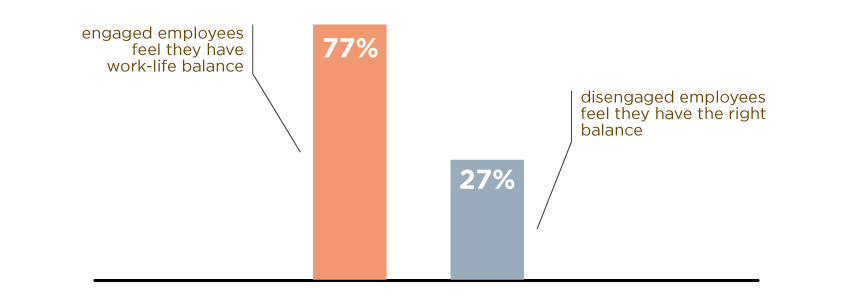Achieving a healthy work-life balance is essential for employee happiness
With technology now permeating every area of our lives, the boundaries between work and home are decidedly blurred. Whether employees are checking their Facebook newsfeed on the company laptop or spot-checking work emails on the bus home, technology now connects us 24/7. However, greater connectivity comes at a cost. With the ability to “switch off” now harder to achieve than ever before, work-life balance has risen to become one of the fastest-growing priorities for business management.
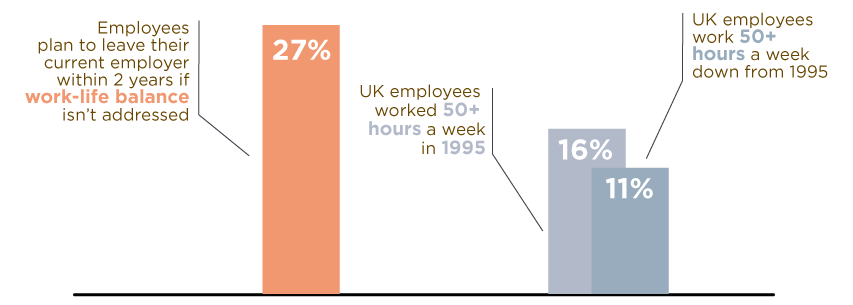
The question is, how can you as a business support your employees in achieving a healthy balance?
Why is the achievement work-life balance essential for business success?
The concept of work-life balance was traditionally dismissed by many C-suite executives back in the 1980s: if you wanted to get ahead, you put the necessary hours and work in to reap the rewards. Achieving a balance was something to prioritize later in your career, post progression – even at retirement age.
However, since the 1990s and in recent years in particular, there has been a notable shift in attitudes. Work-life balance is now considered to be a foundation for business success for a variety of reasons, including:
- Improved employee engagement: the Oracle simply talent report found that 54% of European HR decision makers believed work-life balance makes workers feel more engaged
- Lower staff turnover: payroll software provider Paycircle has no working hours and holiday entitlement is entirely self-controlled. The business has lost just 1 employee in 8 years
- Decrease in workplace incidences / errors: the National Institute of Occupation Safety and Health found that not only were employees with higher work-life balance less tired and therefore less likely prone to errors caused by exhaustion, they were more likely to comply with safety rules and engage with workplace safety projects.
- Boost to employer branding: according to research by UC EXPO, 82% of employees would choose to take a job that offered flexible working benefits over one that didn’t; increasing that organization’s brand and profile as a prospective employer
- Greater innovation and creativity: there’s a reason Google famously promotes unique perks that enhance creativity and personal freedom. One of the organization’s more specialized perks of 20 percent of “free time” within the working day is actually responsible for the introduction of some of Google’s innovative and brilliant products – including Gmail and auto-suggest
Furthermore, the failure to achieve this near-allusive ‘balance’ has been scientifically linked to mental health issues, high blood pressure, gastrointestinal concerns, employee burnout and many other health problems: in research conducted by scientists at University College London, findings showed those who work more than 55 hours a week had a 33% increased risk of stroke compared with those who worked a 35- to 40-hour week. They also had a 13% increased risk of coronary heart disease.
With the Millennials ranking work-life balance over and above financial bonuses or traditional benefits and 27% of employees stating that they plan to leave their current employer within 2 years unless they address work-life balance, it’s time employers took the necessary steps to protect lives of employees outside of the office.
How do I ensure work life balance for my employees?
The tools and tactics deployed by business organizations in the quest for this holy grail of “work-life balance” are well-documented across the internet. Ranging from the bold to the near-obscure, it would seem every business leader is striving to out-do the competition to attract, retain and fully capitalize on the best employee talent. We take a look at the 3 main categories of employer responsibility that can help achieve balance.
1. Flexible working
Offering employees flexibility on how long, where, when and at what times they choose to work is already established practice across many industry sectors. However, the process of managing a flexible program can prove challenging for employers. The main options available are:
- Flexitime: ranked as the UK’s favourite perk in a recent study, 35% of employees claimed flexitime to be their top choice. This allows staff flexibility on when they start and finish – for example, start late and finish late to enable them to drop off children at school. The total number of hours worked amounts to full-time hours, but is split according to times that suit the individual employee.
- Job-sharing: the division of a role between two or more employees. This offers employers double the talent or skills, increased productivity and retention on top of continuous work coverage for periods of annual leave or absence, while employees achieve a greater balance between work and home life.
- Telecommuting: empowered by technology, we now have the capacity to engage with employees and work remotely, regardless of location. 66% of employees would select this option in order to escape workplace interruptions; 32% believe they are more productive outside of the office.
Offering a package that can be tailored to an individual’s lifestyle will enable employees to balance life responsibilities such as children or the care of relatives with work, or potentially pursue interests such as fitness activities, further education or hobbies: all of which will promote better employee health, happiness and engagement.
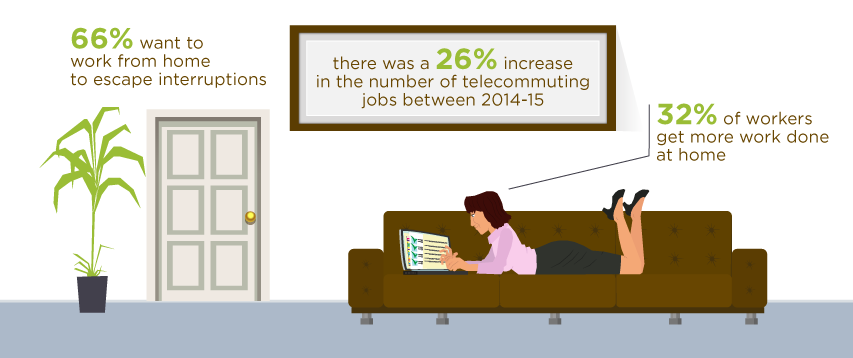
Flexible working winner: a number of big-brand organizations including Colgate-Palmolive, Johnson & Johnson and Microsoft promote flexible working programs for employees; however, Australian marketing firm Filtered Media caught attention when announcing it offers its employees 2 ‘Yolo Days’ each year. Short for “you only live once”, these days take the concept of flexibility to a new level – giving employees the opportunity to wake up and decide to do something different with their day, no questions asked.
2. Reduced working hours
Rather than simply adjusting the timetable, why not consider reducing it altogether? Sweden is a country taking the lead on this seemingly controversial move, initiating the roll-out of 6-hour working days across a variety of industry sectors. The benefits are widely recognized: data from the Organisation for Economic Co-operation and Development (OECD) shows a direct correlation between lower working hours and higher productivity across the world’s richest countries.
The other consideration is annual leave. Despite an increased uptake, many employees still fail to take their full allocated allowance or alternatively, will be found continuing to check work emails beside the pool – failing to switch off and risking the wrath of fellow family members. How can organizations guard against the abuse of given time off?
- Ensure adequate cover: employees are more likely to feel comfortable ‘switching off’ if they are confident that there are individuals in their wake keeping things ticking over.
- Remove any stigma around time off: despite annual leave being a legally protected right for employees, in certain environments a negative perception can brew around individuals taking time off when the business is particularly busy or if they haven’t yet hit target. Ensure a top-down positive mentality, with managers endorsing and supporting the uptake of annual leave – and ensure any misgivings about individuals not being a ‘team player’ are disputed.
- Offer flexible holiday policies: allowing individuals to “buy” additional days of holiday not only provides a tax and national insurance saving for employers, but will also encourage individuals to use their allowance for actual holiday – rather than ‘saving’ annual leave for the likes of childcare emergencies or similar.
- Consider sabbaticals as a company initiative: already offered by large brands including John Lewis, these enable employees to take an agreed amount of time off to pursue travel, education or a personal pursuit; employees offered this option typically demonstrate increased loyalty, engagement and motivation for their roles on their return.
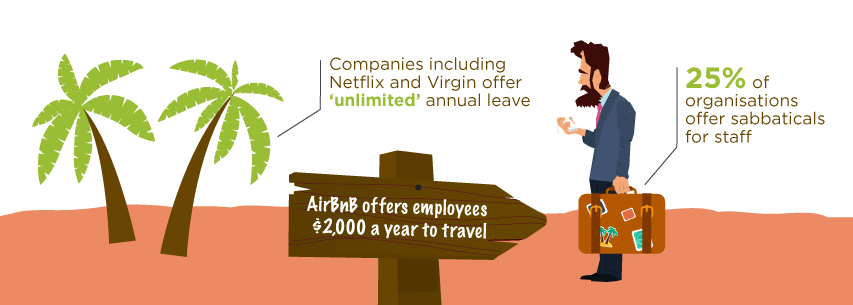
Reduced working hours winner: Airbnb, named Glassdoor’s Best Place to Work in 2016, gives its employees an annual allowance of $2,000 to travel and stay in an Airbnb listing anywhere in the world. Meanwhile, global brands Netflix and Virgin famously offer ‘unlimited holiday time’ to their employees.
3. Improve workplace efficiency and productivity
One seemingly simple answer to improve work-life balance is to improve efficiency of employees during working hours, protecting against the prospect of overtime or work being taken home. Identifying and addressing time-stealers within your organization can be a simple yet highly efficient means of protecting the time of your employees – and your own.
- Rein in the meetings: they cost the UK economy an estimated £26 billion annually, but the plague of pointless meetings continues. Question whether your meetings are necessary – and for those that are, cut the time, have a clear agenda and only include the people you need.
- Improve communication, time-management and processes: support staff in achieving better time management through coaching, training and tools that will enable them to prioritize workloads, collaborate successfully with colleagues and move seamlessly between different systems, platforms and projects. An in-house intranet platform can have dramatic implications for your internal communications processes and drive efficiencies in areas such as sourcing information, providing clear guidance on expectations and visibility of deadlines, removing outdated or tihttps://www.interactsoftware.com/product/interact-7-8/me-consuming paper processes and much more.
- Promote a healthy working environment: it is now well-documented that healthier employees are more productive, innovative and engaged. Support employee well-being and happiness with health focused initiatives: whether that be fruit in the office, gym memberships, health insurance all the way through to staff fitness trackers, sports teams or in-house yoga!
Efficiency and productivity winner: Liverpool-based company Agent Marketing took up the Scandinavian 6-hour working day and managed to be more resourceful with time by cutting 1hr weekly meetings to just 8 minutes and using time management tools to plan out staff days effectively. A mandatory one-hour lunch away from the desk allowed employees to walk the company dog or do a session of ping-pong, with staff returning refreshed and energized for the afternoon. The shorter working day added to a benefits package including weekly morning yoga, daily meditation and in-office massages.
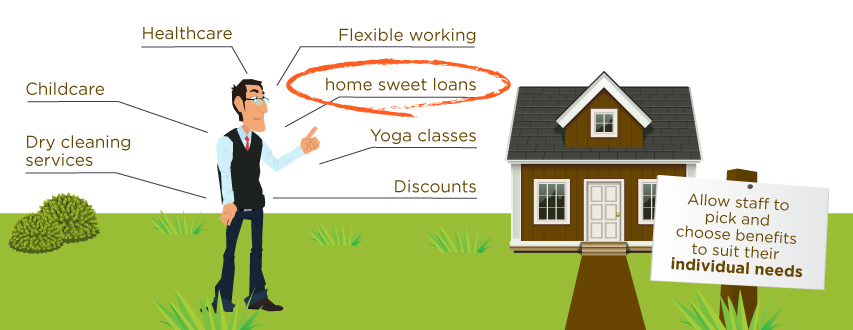
There is no single winner in the race to achieve work-life balance; instead, employers need to look to a “pick’n’mix”-style offering, putting forward a selection of different options that can be opted and tailored to suit each individual. Starbucks, by way of example, is now offering its Baristas interest-free “home sweet loans” to support with paying rent or house deposits, recognizing that getting onto the housing ladder is the top priority for it’s largely U25 employee demographic. Things like this can make a big difference; taking the time to understand the specific concerns and priorities of your workforce will ensure employees feel listened to and supported – promoting not only greater work-life balance, but enhanced employee happiness and engagement.
